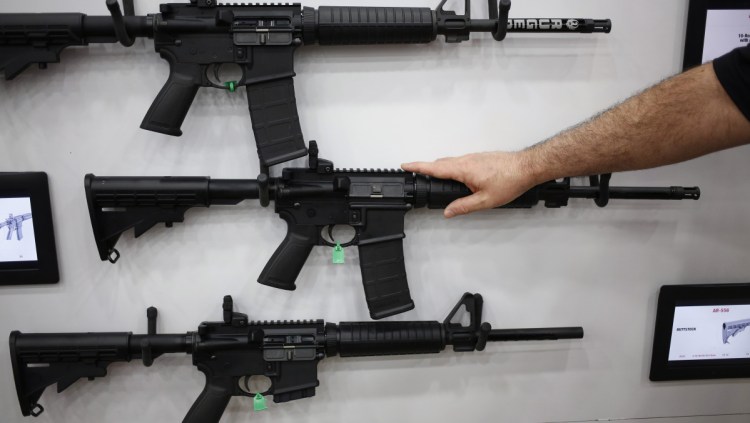When the American Revolution began, most of the Minutemen responding to Paul Revere’s midnight call to arms grabbed what was, at that time, most readily available: a flintlock musket.
Mostly military weapons left over from the French and Indian War, these smoothbore muzzle-loading firearms used black powder, ignited by the spark of a flint stone striking metal. Pretty primitive by today’s standards.
But another revolution already had begun. Regular army soldiers and woodsmen with a few more possum pelts to pay were increasingly switching from smoothbore muskets to long guns with rifled barrels.
This new technology, designed expressly for military conflict, provided far more accuracy at longer ranges, so much so that the British, who preferred to march in formation through open fields, disdained the rebels for having the audacity to hide behind cover and snipe at the slow-moving targets. And when the war ended, veterans brought their rifles home to be used for hunting and protection. With mouths to feed and having just experienced what a corrupt government can do, it made sense.
Ensuing conflicts, mostly with Native Americans, pirates, occasionally the British, and eventually the Spanish in Mexico prompted another technological advancement in military weaponry. More reliable caplock mechanisms replaced flintlocks, which were far less trustworthy and vulnerable to moisture. These military veterans helped establish the fur trade and open the West.
They were also among the most common weapons at the outbreak of the Civil War. But military conflict has a way of speeding up firearms technology, and before that conflict ended, weapons advanced from muzzleloaders to breech loaders, from patch-and-ball powder and projectile to self-contained cartridges, and eventually to the repeating rifle, a weapon capable of firing multiple projectiles without reloading. Folks were a lot more practical in those days, and families were excited to see Johnny come marching home with one of these.
Repeaters persisted in several configurations, the most common and perhaps most famous being the Winchester lever-action. This, even more than Sam Colt’s Peacemaker, was the gun that opened and won the West. To this day, lever-action rifles remain one of our most popular sporting arms, second only to what came out of America’s next military conflict.
While we were “winning the West,” Europeans were doing what Europeans did back then, which is mostly waging war on one another. In the never-ending search for improved technology, the Germans came up with a superior bolt-action Mauser in 1898, to this day considered one of the most reliable and accurate. Bolt-action rifles very quickly became standard issue when the world went to war shortly after the turn of the century. Again, the latest military technology came home and was put out to pasture and woods and mountains, as bolt-actions gradually became the most popular among sporting arms makers and users.
Long story short, a few decades later the world got restless and again went to war. And again, gun makers set to the task of advancing technology, this time creating weapons that could fire multiple rounds with a single pull of the trigger.
These fully automatic “machine guns” were common but not widely issued. Most foot soldiers still carried bolt action or semi-automatic firearms, the latter of which came home and were converted to popular sporting arms like the BAR (Browning Automatic Rifle) and Remington Woodsmaster, the latter being the weapon of choice among those who track big bucks in the big woods.
I suppose, like anything else, there’s a law of diminishing returns when it comes to firearms technology. With the semiautomatic rifle representing something of an apex after World War II, munitions makers turned their attention to ammo, playing with powders and tweaking bullet materials and configurations, mostly to achieve better penetration and accuracy. At least I’m guessing that’s the case, because aside from finding a way to recycle burnt powder gasses to reduce recoil, semiautomatic rifles changed very little in function between the end of World War II and today.
What did change was the form. Wooden stocks were replaced with collapsible, tactical stocks. Grips were designed less for comfort and more for practical purposes like cooling the barrel and allowing for attachment of accessories.
The end result was rifles like the M-16, AK-47 and AR-15. Functionally, they are no different from the guns North American deer hunters have used for the last 75 years or more. They just look different, or maybe it’s something more.
What also changed was our perception and perspective. It’s kind of like those drawings, where if you look at it one way, it’s a horse, then turn it another and it becomes a rabbit.
Even the hunting community initially resisted the introduction of modern firearms into the mainstream despite a more than 300-year history of doing precisely that. But the resistance soon faded as sportsmen began to realize and appreciate certain advantages to hunting with an AR-platform rifle, like increased accuracy, reduced recoil and greater versatility.
The general public perception remains a bit more rigid, and we may have reached the point of diminishing returns on that as well.
Bob Humphrey is a freelance writer and registered Maine guide who lives in Pownal. He can be reached at:
bhunt@maine.rr.com
Comments are not available on this story.
Send questions/comments to the editors.


